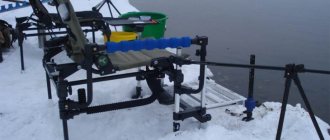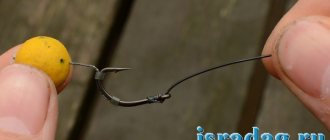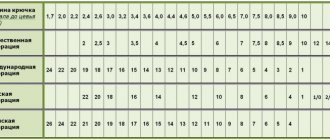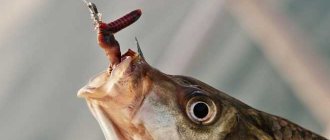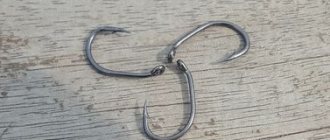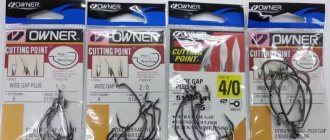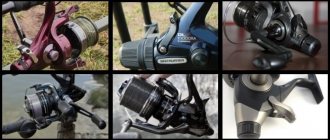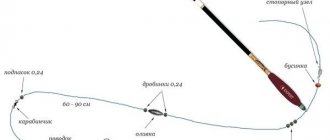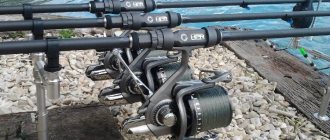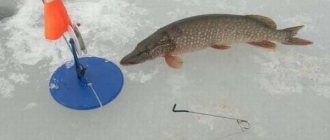Selection principles
If you catch carp with a float rod or feeder, where you immediately hook the fish that has bitten with a jerk of the rod, then you can use ordinary hooks, as for other fish. But in carp fishing, the whole point is to hook the carp under the weight of the sinker.
To understand exactly how hooks are selected for carp fishing, you need to understand the entire mechanics of carp biting. To do this, let’s take a virtual look under the water and break down the process into its components.
- The carp swims up to the boilie lying on the bottom, which is mounted on a hair rig.
- Having become interested in the boilie, the carp sucks it into its mouth, followed by the hook.
- Moving away from the place where the boilie is taken, the fish pulls on the leash, while the boilie tends to leave the carp’s mouth.
- Now, the tensioned structure of the carp and sinker should allow the hook to pierce the lower lip of the fish due to the weight of the sinker and the sharpness of the hook.
- When fishing, the carp shakes its head from side to side, trying to free itself from the irritating hook. But the reliable hook does not bend or break.
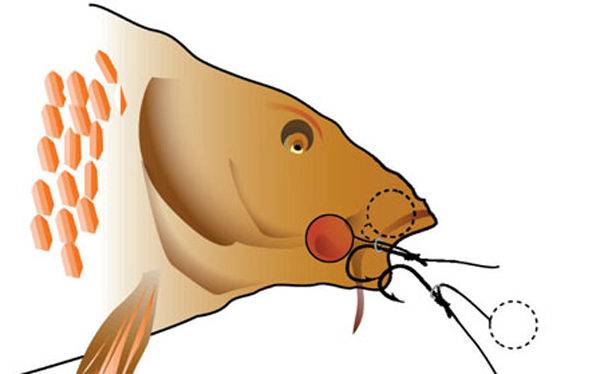
In order for it to happen as described above, the hook must meet the requirements that were specified at the beginning.
General requirements for tackle for carp
Fishing rods, fishing line, hooks and other equipment must be reliable and strong, since fish from the carp family offer powerful resistance to the fisherman.
Therefore, each element is carefully selected and checked. The boat should be no less durable and reliable. Be sure to choose a heavy feeder so that it does not get carried away by the current and the fish can enjoy the treat. The reel must be “running” and powerful so that it can be used to hook the prey in time.
You can catch carp using different gear:
- winter fishing rod;
- float rod;
- elastic band;
- crown;
- donku;
- feeder.
Acuity
The sharpness of the sting should ensure that the carp's mouth is punctured under the weight of the sinker. This can only be achieved with laser or chemical sharpening. No offense to our Chinese friends; many of their products do not differ in such manufacturing features.
Since ancient times, fishermen have tested the sharpness of hooks on their own nails. If you place the point on the nail and try to pass the hook along it, then the properly sharpened product will rest, but the blunt one will slip off. It’s a good idea to carry out this procedure before every fishing trip, and even more so after catching a trophy.
Stealth
Having found our boilie at the bottom of the reservoir, the carp should not even doubt any trick awaiting it on the path of life. Therefore, the hook should be as inconspicuous as possible among the surrounding environment. This is achieved in two ways:
- using black products, preferably with a matte finish;
- by selecting their size relative to the bait.
The most popular sizes of carp hooks are 6, 8 and 10 according to the international classification. The sixth size is used with large boilies, and the tenth - with small ones or pelets. When using attachments of other sizes, the size of the hooks changes in one direction or another. It is most logical to compare the amount of bend with the diameter of the boilie. The optimal solution can be considered when the latter is two to three times larger than the hook.
Clinginess
Perhaps this is the factor that is most underestimated by beginning carp anglers. The hookiness depends on the shape of the hook and how the boilie is mounted on the hair.
Let us consider special cases of the shape of hooks and the installation of certain types of hook configurations.
Classic shape
Such hooks have a bend parallel to a fairly long fore-end with a ring slightly bent inward. In order for the fish to be better caught and not come off when playing, the hair is passed through a tube on the fore-end and made so long that the distance from the bend to the boilie is about 10 millimeters. This distance, and even when the tube on the forend is shifted towards the ring, does not allow the carp to rest against the hook to free itself.
This type of hook is the most common and is used in most carp fishing. It is advisable for beginning carp anglers to start with models of the classic shape.
Inwardly curved sting
Such hooks are used in reservoirs with problematic, grassy or snagged bottoms, when there is a risk of snagging on coastal vegetation. When using products of this type, the distance from the bend to the boilie is kept minimal, one millimeter.
For floating boilies
In this case, the boilie literally sticks to the fore-end. By moving the nozzle along the forend, ensure that the sting relative to the bottom is at an angle of 45 degrees. In this case, the structure becomes more grippy. The wire for making hooks for floating boilies is selected thinner than for classic fishing. This is done to facilitate the hair structure as a whole.
Heat shrink tubes
To improve the grip of carp hooks in carp fishing, special heat-shrinkable tubes are widely used. They help place the hook in the correct plane when biting. Such tubes are put on the end of the leash and the ring of the hook, slightly extending onto the fore-end to a point opposite the beginning of the sting.
The correct selection and installation of the heat shrink tube is very easy to check. The mounted equipment with a leash, a tube, a hook and a boilie is placed on the palm; if, when pulling the end of the leash, the hook turns with its tip towards the palm, then everything is mounted correctly, otherwise it is better to double-check everything.
lovlyavsem.ru
Hook Requests
Fishing, as you know, is a serious matter and requires thorough preparation to return home with a catch. Carp hooks must meet certain requirements:
- The sharpness of the sting, its high-quality sharpening.
- Coating with paint to make it invisible in water, camouflage.
- A characteristic feature of metal is its strength.
- Size and shape.
- Device.
The quality of the metal from which the hook is made affects its strength, which means that the cost is directly dependent on the quality. For example, fishing devices from the well-known manufacturer Gamakatsu, made of steel with a high carbon content without impurities, are of better quality than budget varieties. With all the admiration for fishing, with all the excitement, there is a lot to keep in mind.
The size of the hook and its shape are interconnected with the choice of boilie attachment. The fishing device must be sharp, durable, grippy and invisible.
According to their shape, metal rods with curved ends are divided as follows:
- classic shape, where the eye and fore-end are on the same plane, the tackle is the least traumatic;
- device with a short fore-end;
- with a long fore-end and a sting curved inward;
- with a straight fore-end and an inwardly curved eye;
- with a curved fore-end and a straight sting;
- with an ear bent towards the sting;
- bananas are considered the modern, best form, but this tackle injures the fish.
Knowledge of all the features of the equipment will add success and pleasure, familiar only to the breadwinner, the man.
Hook size and catch size
Before fishing, questions may arise about which hooks are the most suitable, what new products have appeared in the retail chain. Ovner products are in demand due to their high strength. In general, hooks come in different sizes - small and large.
Which one is better to take depends on the circumstances:
- Depending on the bottom topography, which can be soft silt or grass carpet.
- Fish can be weakly active.
- The fact that the fish's lips are thick and hard is taken into account.
- Character of the bite.
- Even the property of the metal used affects the result.
By design, hooks come with a ring-shaped eye or a spatula. Experts say that to get a trophy you need a ring, this is the most reliable means. The strongest hooks are suitable for carp; most often, tackle is specially made using the forging method. Fishermen are more willing to use products with numbers from 2 to 8 in their practice. But there is no single solid numbering system. Rods are also different. Fishing for carp on a feeder is notable for its unusual rod. The flexible upper part of the fishing rod is a kind of bite indicator.
What types of equipment are used
The equipment for carp, and in particular its formation and principle of operation, depend on a number of factors arising from the physiological characteristics of the fish, its habitat and preferences in the choice of nutritional objects. It is worth noting that carp are quite powerful and fast fish, capable of crushing even the most reliable tackle with poor handling technique. At the same time, the fish is very careful and timid, which is why it tries to stay at long distances from coastlines.
The carp prefers to inhabit snags and driftwood, as well as bottom topography with holes, adhering to moderate currents. It feeds mainly on muddy bottoms, as well as on shell rocks and shallow waters with young aquatic growth. The food supply consists of plant and animal food. The plant diet includes cereal seeds, as well as berries that fall into the water. Carp love young shoots of cattails and reeds.
Animal food consists of all kinds of insect larvae developing in the water, as well as mayflies, mollusks, especially zebra mussels, leeches, molting crayfish, fish eggs and the juvenile fish themselves. The use of high reliability parameters for tackle cords is greatly influenced by the presence of a file on the front ray of the upper fin of the fish, which often causes cut-offs of equipment when fighting hooked fish.
Based on all the features presented above, carp fishing relies on bottom rigs for long-distance fishing strategies and float rods, mainly fly rods, if fishing is planned to be done from a boat or a cliff hanging over a reservoir. Fishermen use both universal purchased and homemade gear, tailored specifically for carp.
Feeder tackle
The feeder belongs to the bottom type of equipment, combining two important features that help catch carp - the ability to fish at long distances, over 100 meters, while simultaneously forming a feeding table that attracts fish. The feeder fishing rod for carp is distinguished by a length parameter starting from 3.5 meters and above, as well as a large dough, selected from 80 grams. The medium action of the blank, shifted towards the slow one, helps to effectively fight with already caught fish and notice its careful bite.
A spinning reel is selected under the rod with the obligatory presence of a baitrunner and a safety cable on the butt of the tackle. The device size is at least 3500–4000 units. The spool should hold about 200 meters of 0.25 mm braided cord. The power and traction mechanism covers the harsh conditions of carp fishing.
Shock leaders and ties are used in the rigging of the lines, allowing you to feel subtle bites in current conditions. The use of feeders varies from classic metal or plastic meshes to method and spring options. A thin braided leash with a length of 20 to 40 cm is placed on the feeder, equipped with a hook number 8–10.
Bottom gear for catching large carp is assembled according to the principle of carp equipment, which is based on replacing the feeder with a blind sinker, which allows the fish that takes the bait to self-hook. Such installations are completed on specialized carp rods or spinning rods with large tests. The rod is equipped with carp low-speed spinning reels equipped with a braided cord having a high breaking load.
Often, in this type of equipment, hair equipment is used, when installing gear for fishing with corn or boilies. When a fish tries the bait, it hooks itself. The bite is controlled by various signaling devices based on the principle of operation. The signaling device can be either a regular bell or an electronic light and sound system with a pager. Carp equipment is convenient for fishing with several rods at the same time at any time of the day.
Experienced fishermen often choose bottom gear, since they have to catch carp from afar and from the bottom.
Feeder gear differs from bottom fishing rods in the presence of special tips that signal a bite. These tips are called “quivertips”.
The components of the feeder are:
- A rod 3–4 meters long with a soft tip, which signals a bite. A certain number of guides must be attached to the rod.
- The reel must be powerful and have two clutches.
- It is recommended to choose a monolithic, strong fishing line with a diameter of up to 0.4 mm. Since the use of a feeder assumes that the feeder will be cast far, the recommended line length is up to 180 cm. The diameter of the leash line is up to 0.2 mm.
- The feeder will additionally serve as a sinker, so it should be chosen weighing up to 120 grams. With its help, nothing will prevent successful fishing for carp at depth in any current.
- Hooks for feeder equipment are short, strong fore-ends with notches. When they are pryed, there should be a little spring, and the strong tip of the hook should be notched.
We suggest you familiarize yourself with: Purchased and DIY tackle for carp for different bodies of water
Donka for carp
Bottom fishing rods are gear for fishing without rods. With their help, bait can be given to fish directly at the bottom of the reservoir. Most often, donkey casting is done from a boat. Its components are:
- Line up to 50 meters long. Experienced fishermen choose monofilament that matches the color of the river or lake bottom.
- For leashes with a length of 25 to 40 cm, a fishing line with a diameter of 0.3–0.4 mm is selected.
- A powerful coil is desirable, although its choice does not play a special role.
- The weight of the sinker depends on the strength of the current. For a strong current, its weight should be from 80 to 100 grams, and for a weak current, 40–80 grams.
- It is better to use a carp hook size No. 2.
To catch carp, persistent baits are used. It can be unsteamed cake or worm.
Makushatnik
In this bottom fishing rod, instead of a feeder with bait, a metal plate is used, to which leashes with hooks are attached. Components:
- sinker weighing up to 100 grams;
- durable monolithic fishing line with a diameter of 0.4 mm;
- sharp and large hooks size No. 8;
- a metal plate approximately the size of a matchbox that acts as a feeder.
Makukha (a piece of aromatic cake) is attached to the plate. Hooks are stuck into the cake, which are masked with bread crumbs or covered with clay. This design is highly sensitive to even minor bites.
How to make tackle for carp?
Having all the necessary equipment available, you can make gear for catching carp with your own hands.
Donka-zakidushka
Donkey assembly process:
- First of all, leashes are prepared, the number of which depends on the desire of the fisherman. In most cases, they are made no more than five pieces, 10 centimeters each. The hooks are attached to the fishing line using a figure eight knot.
- A weight is attached to the main line, and then leashes are attached in increments of 15 centimeters. The distance from the load to the first leash should be 40–45 cm.
- At a distance of 10 cm, the main line is cut from the last leash.
This type of casting rig is used for catching carp from the shore. They attach it to a peg stuck deep into the ground. To determine whether a fish is biting or not, bells and bells are used.
Donka with a feeder
The advantage of this design for catching fish is the possibility of baiting it, which increases the chances of catching prey. Its distinctive feature is the presence of a spinning rod with a reel, which must be inertia-free. The rod is selected in sizes from 2 to 2.5 meters, it must be strong.
The feeder is an important part and can be purchased at a fishing store or made with your own hands. When choosing the material for its manufacture, the type of reservoir is taken into account. In lakes, round feeders made of wire or plastic are used. In fast-flowing rivers, choose a triangular or rectangular feeder, but it must be heavy.
How to tie fisherman's knots
Successful fishermen know and can do a lot, including how to securely attach a hook to a fishing line. Beginner anglers will have to learn how to tie fishing knots if they want to bring home carp and carp. Knots are different; in each specific case, the most convenient way to tie a hook is used. There are about 15 types of fishing knots known; you can learn how to do this correctly from experienced fishermen, or you can use video tutorials on the Internet. We tie knots for carp, taking into account some nuances. The fact is that carp is capable of developing traction tension in the aquatic environment, and of an impressive magnitude, 4 times its own weight. A skillfully tied knot holds the hook even under pressure of up to hundreds of kilograms.
With practice comes the ability to prepare gear for carp, summer or autumn carp. The larger the size of the boilie nozzle, the more weight you need to attach the catching device.
All that remains is to wish you a good, rich catch! In water, carp is a real master, loves to eat deliciously, knows how to adapt to the bottom, get away from the bait, lie down on its side, hiding from the net. When going after carp, you need to realistically assess your capabilities and take into account the ability of this fish to nullify all preparations.
orybalke.com
Other gear
They are used much less frequently than bottom ones. Firstly, this is a float rod. It is used when fishing in stagnant reservoirs in thickets of aquatic plants, where using a donkey is problematic. When fishing for carp, a fairly strong line is placed on the fishing rod and a fairly strong rod is used. The fact is that this fish reaches large sizes and weights and resists very stubbornly. Catching a carp with a fishing rod is an unforgettable feeling when the angler makes a lot of effort to pull out the caught fish.
It is more convenient to fish from a boat. The boat allows you to sail away from the shore, use the water thickets as an anchor, anchor yourself to them, and allow you to fish in many more places. It usually makes sense to fish at depths of one and a half meters, and most of these places may be inaccessible from the shore. When fishing, you can use either a worm in the form of an animal bait, or a top, using a hair or homemade carp rig.
Victoria Leshchenko
I've been working hard in the fishing tackle department for the past six years. I can help you assemble almost any gear.
Ask a Question
However, the need to separate the bait and hook is not so acute here, since the float allows you to see all the movements of the fish and perform the hook in a very timely manner.
Sometimes carp are caught using a summer jig. This is a tackle with a side nod, which allows you to play with a jig. Here you need a rod with a reel so that you can immediately release the required amount of line when catching a fish, otherwise you can break the rod. They use a jig with an attachment; much less often, they fish with a devil without an attachment. The attachment is a worm. Carp detects a jig faster than a standing rig, even among abundant bait, and is more likely to bite on it, especially when he is not too hungry.
This kind of fishing brings good results on paid carp anglers. The fish there are heavily fed with compound feed and fishing baits, so they are quite indifferent to all sorts of fisherman’s tricks in terms of selecting baits and baits. The author fished on such a reservoir. The carp, standing close to the shore, refused to respond to any bait thrown under its nose. He was simply caught out of the water with a net when the guard was not looking. But the summer jig gave a good result the next day.

In Japan, there is a cohort of amateur fishermen who fly fish for carp. It is likely that such gear can be used in our country. Fishing is done at shallow depths, up to two meters. When fishing, both nymphs and dry flies are used, and sometimes streamers are used. They use classic fly fishing from the fifth to sixth class, which allows you to both cast far enough and cope with large carp.
Fly fishing gives better results compared to float and bottom fishing, probably for the same reasons that fishing with an active jig is better than fishing with standing tackle. This is also a more sportive fishing, which allows you to fight with fish on an equal footing, and makes it possible to deceive it with artificial bait. Probably, other “Japanese” fishing methods, such as herabuna, fly fishing without a tenkara reel, can also be used for catching carp.
For fishing from a boat, side rods are used. Usually, carp are caught in this way closer to autumn, when it rolls down to depth, from where it soon moves on to winter camps. Carp bites often occur when catching bream with a ring from a boat. You can fish with side rods with a hanging or bottom sinker. However, you should avoid places with strong currents - there carp, as a rule, do not feed and bite much less often.
Methods for selecting hooks
When fishing with a feeder or float, where the hooking is done quickly and sharply, you must use ordinary hooks that are suitable for catching any other fish. Otherwise, the choice should be approached very carefully. Experienced people who use boilies to attract carp understand that the mechanics of biting are sometimes very difficult, so before choosing hooks you should first pay attention to this point.
Choosing a hook when fishing with boilies
First, the fish swims up to the boilie, which lies on the bottom. Having sniffed the bait, the carp begins to absorb it or immediately takes it into its mouth. Along with the treat, a hook hidden in the product also enters the mouth. After this, the fish begins to swim to the side in order to move away from the place where it refreshed itself. At this moment, the leash tightens, and the boilie is ready to fall out of the river inhabitant’s mouth. Given the unusual design, due to the weight of the sinker and the sharpness of the hook, the lip of the fish should break through. If you use reliable carp hooks, they will not bend or break.
Read more about the technique of catching carp with boilies and choosing bait.
This is why it is so important to choose proven elements, because otherwise the part will fail at the most inopportune moment. The first thing fishermen pay attention to is the strength of the product. When purchasing, you need to take this into account so that during fishing the fish does not get away “from under your nose.” High-quality elements are parts that are made of heavy-duty wire. Among the exceptions are only light models that are intended for floating boilies.
It must be said that strength can be achieved through proper processing of parts, during which first hardening occurs, and then sudden cooling. A high-quality element is springy, but at the same time it does not bend, much less break, unless, of course, the permissible load is exceeded.
What size should it be
Having dealt with the density, you can move on to the size. The carp hook, or rather its size, depends directly on the size of the boilie. So, the width of the hook can be two to three times the diameter of the ball. If you overdo it with hooking, then, most likely, the fish will feel the coldness of the metal when it starts to swallow the boilie and will abandon this idea, sensing something is wrong. The same applies to parts with a narrow underhang, because they will not be able to catch on the lip of the fish at all.
Hook sharpness
The sharpness of the hook also plays an equally important role. In order for the product to be perfect, it must be chemically or laser sharpened. There are anglers who prefer to catch carp with Chinese hooks - they are inexpensive, but often fail. Of course, everyone chooses products for themselves, but it is better not to skimp on such details.
Important! You can check the sharpness of the hook right in the store. To do this, you should place the point on the nail and try to draw the hook along; if the product sticks, the sharpening is correct; if it slips, the part is dull.
Experienced people recommend resorting to this manipulation not only during purchase, but also before every fishing trip, because hooks tend to become dull, and there is nothing strange about this.
The next point that is worth paying attention to is invisibility. Having noticed a boilie at the bottom, the carp must be sure that there is something tasty waiting for it there, and there is no trick in it. That is why the hook should be invisible among other elements and everything that is at the bottom.
This can be done in several ways. Firstly, it is advisable to use black parts. You should also pay attention to having a matte finish. Secondly, the size must correspond to the bait, this is what was discussed above. The most popular number is 6 . Although eight and ten are also used, based on the international classification. The sixth size is suitable for large boilies, and the tenth for small boilies.
Important! If there are difficulties and the fisherman does not know which carp hooks to choose, it is better to first purchase boilies and go from there.
Novice fishermen do not pay attention to the catchiness, but in vain. It should be noted that this nuance depends on the shape of the hook itself, as well as on the installation of the boilie on the hair.
How to tie a hook to a fishing line
Particular attention should be paid to the installation of hooks, as well as their shape.
It is advisable to start with the classic form. The presented elements have a bend that runs parallel to the fore-end. It also has a ring that is slightly concave inward. In order for the carp to hook better, it is recommended to pull the hair through the tube and leave a distance of about 10 mm from the boilie to the bend. This is the ideal distance that will prevent the fish from pushing back. Very often, carp fishing is done with just such a hook, because it is considered one of the most popular. By the way, it is better for beginners to pay attention to the presented elements.
Read our selection of 29 ways to knit hooks to fishing line.
On sale you can find hooks with a sting curved inward. They are good to use where there is a lot of vegetation and all kinds of snags at the bottom. Due to the small bend, the likelihood of catching something is minimal.
Special hooks are also made for floating boilies, where the balls, one might say, stick to the fore-end. By moving the treat along the fore-end, you can ensure that the sting is at an angle of 45 degrees relative to the bottom. This design is catchy. Hooks for catching carp in this case are made of thin wire. This was done for good reason, so that the hair structure was not so bulky and heavy.
Experienced fishermen know that to ensure good grip, they use special heat-shrinkable tubes in carp fishing, which help with the bite and position the hook in the desired plane. In order to tie tubes, you need to put them on the hook ring and the end of the leash, bringing the element behind the shank to a point opposite the beginning of the tip of the hook.
Installing heat shrink tubing is not difficult. If, after assembly, you place the element on your palm and when pulling, pulling the end of the leash, it turns out that the hook turns with its tip towards the palm, then everything is done correctly. If something is wrong, then you need to check everything carefully.
When buying hooks, you need to pay special attention to them, so that at the most opportune moment it does not turn out that the elements are of poor quality or that they do not fit the existing bait at all.
iarybak.ru
Float fishing rod for carp
This type of rod can be used for fishing on a pond from a boat or hunting prey in deep places in rivers that are located near the shore. In this case, the reservoir should have a weak current or areas of rotational movement of water.
The most suitable rods are the following:
- Karpovoe. Its length should be at least 5–6 meters.
- Spinning. Choose a fast action fishing rod, which has a length of 2.7–3 meters and an increased test of 80–100 g.
If fishing will be done from a boat, then a shorter rod is selected than when fishing from the shore.
The advantages of a float rod include:
- The structure allows you to replace any parts of the equipment yourself if necessary.
- With the help of “dead” equipment you can fish in thickets of algae and among snags, where carp often live.
- The versatility of the gear, which can be used regardless of the type of prey and the choice of fishing location.
- Lightness of design.
Float fishing rods also have disadvantages:
- rods without a reel and rings are unsuitable for fishing from steep and steep banks;
- with their help it is impossible to fish in strong currents and from steep banks;
- the tackle is cast with a fishing rod only over a limited distance;
- The line often gets tangled because it does not follow the rings.
When using fishing rods, select the following equipment for catching carp:
- The reel should be inertia-free, which even a novice fisherman can handle. The success of fishing will be ensured by the presence of a friction brake, a wide range of reeling speeds and the ability to easily throw the bait over a long distance.
- The weight of the sinker depends on its location on the fishing rod and the fishing location. If during a test cast the float moves sideways or lies on the water, then the weight of the sinker must be added, and if the float goes under the water, then it is worth reducing.
- A sliding float is necessary, since carp is a dynamic and strong prey. A goose feather float attached to the fishing line in two places is best.
- The sizes of hooks are selected taking into account the size of the intended prey. If fishing is planned for large specimens, then the hook numbers should be from 5 to 7.
- The fishing line should be selected as strong as possible. It is better if it is a well-stretched and low-tearing monolithic fishing line with a diameter of 0.6–1 mm.
We invite you to read: Carp fish: description with photos, habitats, spawning, fishing
Types of hooks for carp and carp
There are both universal types of carp hooks, and models made taking into account certain fishing features - for example, the topography of the bottom of vegetation on it the bait used , as well as the size of the fish and biting activity.
There are the following types of carp hooks:
- Wide Gap . the tip of which slightly curved inward for comfortable fishing in reservoirs with an abundance of bottom vegetation, as well as preventing its premature wear when fishing on a rocky bottom .
- Banana. This model has a long curved fore-end, shaped like a banana. The main feature is excellent carp hooking, but it is also a disadvantage, since due to the long lever there is a high probability lip tearing or the hook breaking even with moderate force. Often sports fishermen refuse this model because they believe that the “banana” is too traumatic for the carp.
- Long Shank. A model that also has a long fore-end, but, unlike the previous model, it is straight. It catches carp well, most often just by the lower lip , but it has the same disadvantages that are inherent in the “banana” - it easily injures the fish, tearing its lip, and is also susceptible to fracture.
- Curve Shank. A universal model with a wide-curved fore-end of medium length. Suitable for both sinking and floating baits. Particularly convenient for attaching several boilies to a hook.
- Short Shank. A hook that has a short shank and very little hooking. Used in difficult fishing conditions - among snags, abundant vegetation and on a rocky bottom. This model allows you to avoid frequent snagging on foreign objects and keeps the tip sharp for longer, however, it also has a consequential drawback - this form somewhat reduces the effectiveness of hooks.
The best baits and lures
For fishing, bait of animal and plant origin can be used.

The most popular animal baits:
- Dung worm - this bait is always in first place among fishermen. The worm can be used on its own or as part of a sandwich with corn, but at any time of the year carp are caught very well with this bait.
- Maggot is the larva of a blowfly, used for fishing in cold water. In such temperature conditions, the bait remains active longer, and its movements attract fish. Several maggots are placed on one hook.
- Bloodworm is a mosquito larva, which is also successfully used. Often fishermen string bloodworms onto a hook, along with maggots. Carp bites very well on such a sandwich in the spring or early morning in the summer.
The most popular plant attachments:
- Semolina porridge - prepared from semolina and water. After the water boils, you need to add semolina with constant stirring in the amount of 200 grams per 1 liter of water. Then the porridge is cooked over low heat for 10 minutes. Vanillin, a little honey or another attractant is added to the prepared porridge, which will be to the taste of the carp. After cooling, the porridge is cut into small cubes, which are then placed on a hook.
- Canned corn - this bait is the most catchy in the summer. If you plan to catch a large carp, then several grains should be strung on the hook. The corn is strung across the hook; it is advisable to choose for this purpose whole, elastic and small-sized grains.
- Potatoes – this vegetable must be boiled in its skins until half cooked. Already directly at the fishing site, the potatoes are peeled, cut with a sharp knife into small cubes, which are strung on a hook.
Characteristics of carp hooks
Depending on the characteristics of the sting, beard, forearm, bend, ring or spatula, as well as coloring you can choose a hook for carp fishing that will be more catchy in each individual case.
Hook tip
Today, carp hooks with a straight or inwardly curved sting are used, while outwardly curved stings are practically not used.
Both options have approximately the same popularity, however, the tip curved inward retains its sharpness when fishing in difficult conditions with a greater likelihood of snagging on foreign objects. Also, many anglers believe that inwardly curved sting provides a more reliable hook on the carp.
The most important characteristic of a sting when choosing a hook for carp fishing is its sharpness. Checking it is quite simple - you should run the tip along the nail plate at such an angle, in the position in which it will presumably detect the fish. If the hook clings to the nail plate, leaving a groove on it , then the sharpness of the hook is satisfactory. If the tip slides along the nail, this product should not be used, since hooking the fish is not guaranteed.
Hook beard
Some companies produce barbless hooks. The function of the barb is that it prevents the fish from leaving when reeling, although hooking requires slightly more force to penetrate the fish's lip . Therefore, barbless hooks are used mainly for sport fishing, and products with a barb are used by amateur fishermen. It is also believed that hooks with a missing barb are less likely to injure the fish, which is important if the caught carp is released .
Long or short hook shank
For carp fishing, hooks with both long and short shanks are used. A product with a long shank provides better hooking of carp, however, such a hook is more noticeable, therefore, in those reservoirs where the carp is capricious and shows greater caution, it is better to use hooks with a short shank, since they are less noticeable. If the carp actively bites, it is better to use hooks with a long shank .
Also, the forend can have a different shape - be smooth or curved. The curved shank allows for faster rotation of the hook in the carp's mouth and hooks when the leash is pulled.
Bend the hook
For fishing with floating boilies, as well as in zig-rig , hooks with a wide bend are mainly used.
This design provides better hooking due to a larger area of tissue capture on the carp’s lip, which prevents fish from escaping as a result of lip breakage.
However, a wide bend increases the likelihood of the hook breaking when catching large trophy specimens. Products with a narrow bend are more durable.
Ring or spatula
When fishing on a feeder, as well as using floats it is more advisable to use hooks with a spatula, since this design provides the product with less weight and promotes a more natural feeding of the bait, which activates the fish’s bite. However, some types of gear for carp fishing - for example, the flat method, Gardner equipment, the use of hair equipment - cannot be made with hooks with a spatula, so products with a ring .
Color
Coating the hooks with Teflon, bronze or nickel not only has a camouflage function, but also protects the product from corrosion when exposed to adverse environmental factors. Also, some companies claim that a smooth coating provides better rotation of the hook in the fish's mouth and, as a result, more effective hooking, but many anglers view this as a marketing ploy.
These coatings are most often painted in dark colors - black or dark green, but there are other options. You need to select a specific color based on the prevailing colors of the environment in a particular body of water - if there is dark soil on the bottom without vegetation, it is better to use black , and if there is an abundance of vegetation you can use dark green hooks .
Fishing practice when catching carp
All tackle for carp have one feature. When fishing for it, the bait is not placed on the hook, but is carried with it, and the hook is placed on a separate flexible leash. This is done because the carp swallows the bait, it passes further into the stomach, and the hook, like a foreign body, tries to throw it over the gills. This way he sits securely on the hook. Catching it any other way is not very effective. Firstly, he feels the hook in the bait well and spits it out faster. And secondly, when catching it, most often they use relatively hard baits, makukha and boilies. They are not originally intended for mounting.
Classic hair carp montage
Hairline carp rigging is an essential feature of English carp fishing. It consists of a hook, which is attached to the main fishing line on a leash. Typically, the fishing line passes through a bottom sliding sinker-feeder of a flat type. A thin hair leash is attached to the hook, and a floating boilie attachment is attached to it. The boyle is inserted using a special needle, through which the hair with a special loop is threaded through it. The hair mount is made on the basis of purchased accessories, which can be purchased at a specialized carp store.
When thrown into the sinker-feeder, food is filled. The boilie with the hook is pressed into the bait by hand. After casting, the feed is washed away and a feed spot is formed. The boilie with the bait floats above the bottom, having been washed out of the bait. They are clearly visible to fish among bottom vegetation and silt, and this method prevents the hook from getting tangled when casting and the fact that it, together with the bait, will catch on a grass stem, sinking after the sinker to the bottom, and will not be visible to the fish, hidden by it.
There are many subtleties in hair montage knitting. These include buffer silicone beads, feeders, and all sorts of interpretations about what the length of the hair should be, the length of the leash, what kind of knot to tie, whether or not to install a swivel, and how many to install, etc. All these are the subtleties of English carp fishing, and this can be done Dedicate a separate article. Here it is worth considering an alternative method of carp rigging, which may be the prototype of the English carp donkey.
Homemade carp installation
This installation was described in the almanac “Fisherman-Sportsman” in the article “Catching carp with a line. It is indicated that it is used by local residents in the Amur and Ussuri rivers. Most likely, it is also traditional for China and Japan, from where this fish came to Europe along with other achievements of Eastern culture. It differs from English hair installation in that the hooks are located on a flexible leash after the nozzle, and not in front of it, and the nozzle itself is attached to the fishing line.
The mentioned article talks about the transition to carp. It is placed across the river during fish migration to spawn. The main line is a wire to which leashes made of thin twine are attached. A hook is attached to each of them on a so-called “tip” - an analogue of a hair rig. The hook is made of a special shape and has no sharp parts; the fish has no chance of pricking itself on it. When biting, the fish takes the bait, sucks it in its mouth and swallows, and the hook, which is then retracted, is thrown over the gills as a foreign body, securely sitting on it. There are also recommendations on the selection of knots and the equipment of the net, so that the fish can be removed quickly along with the leashes and then the net can be re-equipped immediately with other leashes with a nozzle prepared in advance.
In modern fishing, such equipment also occurs. Usually you take a tackle with a sliding sinker, to which a leash with a loop for the nozzle is tied. The attachment is sawn and drilled soybean cake or makha; you can use homemade boilies, bread rolls, undercooked potatoes and others, depending on the local preferences of the carp. Then a loop is made behind the nozzle and a tackle of one or two hooks tied to a flexible nylon thread is attached to it. Two hooks are installed for security. They are not secured in any way in the nozzle and dangle freely. This type of tackle works similarly to a carp net. The fish grabs the bait, swallows it and after it the hooks are pulled into its mouth. The carp is reliably spotted and caught.
Compared to the one described above, English bottom tackle has a number of advantages.
Firstly, in English gear there are more chances that the fish will be caught by the lip. Homemade equipment is usually quick-release, and the hooks are removed from the fish at home, so catch-and-release fishing is only possible with English equipment. Secondly, this is a more reliable fish detection. Catch-ups when catching carp using English carp gear are quite rare. Finally, hair rigs are less likely to get snagged when fishing in grass.
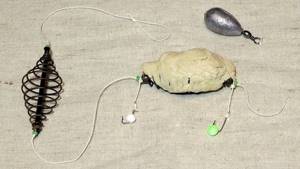
Manufacturers. Top 5 brands of hooks for carp/carp fishing
As in any other industry, there are manufacturers of hooks for carp fishing, which are recognized by most fishermen as the standard for the quality of their products.
The most popular manufacturers are:
Gamakatsu
Japanese company founded in 1955. The first samples of hooks were made manually, and already in 1963 production was automated. The company produces hooks for both sea and freshwater fishing , including carp hooks aimed at the European market.
The products are made of high-carbon steel and undergo two stages of sharpening - mechanical and chemical.
Gamakatsu is credited with pioneering the invention of the inward-curved hook hook.
Owner
A Japanese company that has been supplying the market with a wide range of fishing products for more than four decades, including high-quality carp hooks with the company's patented Cutting Point sharpening, in which the tip of the hook is a trihedron like a samurai sword. The principle of the company is highly specialized production, in which a specific model for each type of fishing for any type of fish .
Hayabusa
A Japanese manufacturer of fishing products and accessories, which was one of the first to register an official representative office in Russia, becoming the founder of modern carp fishing. One of the three leading companies in the world in the production of fishing hooks.
Fox
Founded in 1967 in the UK, the company today represents about 3,000 items in its product range in 30 countries , including Russia, Japan and the USA, in which carp fishing occupies a special niche.
Saikyo
A Japanese manufacturing company that produces carp hooks in the middle price segment , which makes them quite attractive in terms of price/quality . Hooks are produced by stamping followed by chemical sharpening of the tip. The products are quite durable, allowing you to catch even trophy carp on small hooks, and the quite affordable price eliminates the influx of fakes.
Choosing the hook size for carp/carp
The hook size for carp fishing is selected based on the bait used:
- №1 — №2 – when fishing with dumplings, pasta or shellfish meat, as well as potatoes.
- №4 – when fishing with vegetable baits – corn, beans. Also No. 4 is used when fishing for maggots.
- №6 – for packing larger grains of corn, peas and pearl barley.
- №8 – for fishing with wheat or larger peas, as well as when attaching bunches of maggots.
When fishing with boilies, the size of the hooks is selected as follows - one third or half of the diameter of the boilie used should be equal to the distance between the shank and the hook tip.
How to tie a hook?
The following types of knots are used for tying hooks :
Leashed
One of the simplest and most universal knots, which allows you to tie a product with both an eyelet and a spatula. Performed according to the following algorithm:
- An open loop is formed along the forend.
- The free end of the fishing line is wound around the loop and fore-end 7-8 times .
- The free running end is passed through the loop.
- The knot is tightened by tension at both ends of the fishing line at the same time.
Clinch
A classic knot used for products with ears .
- The free end of the fishing line is threaded through the eye and 5-7 times from bottom to top onto the root end.
- The free end of the fishing line returns to the first turn and is threaded into the loop, which is next to the ring .
- The free end of the fishing line is threaded into a loop located along the root end .
- The knot is tightened at both ends.
Trombone loop
Suitable for all types of fishing lines , including fluorocarbon ones that are quite capricious to knots.
- With the free end of the fishing line, the length of which should be about 10-15 cm , an open loop is formed, the middle of which is applied to the fore-end.
- , 8-10 turns are made around the fore-end and the root end of the fishing line.
- The free end of the fishing line is threaded into a loop .
- The knot is moistened with water and tightened at both ends.
How to make tackle for carp with your own hands
- The reel is installed in the rod holder and secured in it using a retaining bar or nut.
- The end of the main line is passed through the rings of the spinning rod. The fishing line is attached to the spool with a knotted loop. The bracket must be open while folding the line. After the process is completed, the bracket closes and the line is wound onto the reel.
- The feeder is fixed to the main fishing line, at the end of which you need to make another knotted loop. A leash is attached to it. If the fish is baited first, then so that the leash does not get tangled, it is installed later.
- Hooks are attached to the leashes using knotless fasteners.
The finished donk with a feeder is equipped with a bite alarm and installed on a prepared stand.
Which bait and bait should I choose for carp?
The most popular bait is a worm, although carp is a very voracious fish and can eat almost everything around it. Dung worms and crawlers work best. Other types of attachments are suitable:
- porridge: semolina, corn, pea, wheat, etc.;
- various types of boilies;
- cake;
- potato;
- dough;
- bread crumb with crust;
- pasta.
The bait may also be different. However, in this case, the main thing is not to overfeed the future prey, so you should feed in large fragments.
It is easy to assemble the tackle for carp yourself from common fishing accessories; besides, by individually completing the equipment, the angler will be able to take into account the nuances necessary for fishing for the specifics of the chosen place and the planned size of the trophy in the catch. As we have already mentioned, the algorithm itself for sets of bottom and float tackle is similar to the classic assembly of devices for most types of carp fish, the only differences are in their parameters of increased reliability and high breaking load of the cords. In continuation of the article, we will focus on the most popular types of making and assembling carp tackle with our own hands.
Float rod
Fishing tackle for carp, based on a fly rod, is used for fishing at short distances from shorelines over ledges and from cliffs above the water, as well as from swimming devices. More convenient are water areas with low current strength, backwaters and creeks in shallow waters, where carp are suitable for searching for food.
The main line is taken with a diameter of at least 0.3 mm. The float is of a spindle-shaped type, no heavier than 3 grams. The lower part of the float should be painted in discreet colors close in shades to the color of the water, which is not so alarming to shy fish. The load is distributed along the fishing line in the form of a garland that decreases in weight towards the leash.
The bait for carp is formed on a slow action spinning rod with weights of 40–80 grams. The length of such a rod should be within 3-3.5 meters, which will guarantee the possibility of long-distance casting. The spinning rod is equipped with a power spinning reel with a baitrunner and a gear ratio of up to 3.5-4.5 units.
The main cord is taken to be braided, which transmits bites from long distances much more effectively. The installation itself may vary in its options, including a combined blind weight in the form of a feeder or a classic weight with a fastening loop. The leashes are knitted from thin braids, up to 0.15 mm thick, painted in discreet color tones similar in color to the silty or clayey bottoms being fished.
The length of the leash should not exceed 40 cm, based on the principle that the more active the fish, the shorter the leash. After casting, the bottom tackle is installed on a stand on the shore and equipped with an audible alarm, and is necessarily secured by attaching it to a cable that prevents the fish from pulling the cast into the water.
Makushatnik
One of the catching gear for catching carp is considered to be equipment using a macaque. Pieces of pressed cake from sunflower seeds are attached to a special flat-looking platform - a sinker, which is made in the shape of a dovetail and has devices for rigid installation of the bait.
In the bait itself, in its corners and the center of the upper edges, there are holes where the hook is mounted. Usually, for carp hunting, four to six hooks are placed on the top of the head. The hooks are tied onto monofilament leashes with a diameter of 0.25-0.30 mm, the length of which does not exceed 7–10 cm. The leashes are attached to the platform in special mounting holes.
Depending on the strength of the current in the fished area, the mass of the platform is selected, which should not be moved by the stream when set up. Typically, the weight of this combination sinker is in the mass range from 80 to 160 grams. To cast a rig with a spinner, use a feeder rod or a mid-standing spinning rod.
We suggest you read: What gear is better to catch carp?
Match fishing rod
At long distances, in addition to using donks with a feeder, anglers successfully use the method of catching carp using a match fishing rod. When fishing for this powerful fish, choose fast match gear 4-4.5 meters long with the highest test in this class. The fishing rod is equipped with a spinning reel with a finely adjustable clutch, 3500–4000 units in size.
This tackle for fishing from the shore has a number of nuances in the fishing technique that relate to the specifics of catching carp. In particular, anglers never clip the line to fix the casting distance, since when fishing, the fish can take a significant part of the line, which will lead to a break in the installation when installing the line in the clip. In addition, when hooking a trophy, it is pumped out by the joint work of the rod and reel without forcing it with accelerated reeling.
Spring
A tackle with a spring-shaped feeder is effective in catching carp. The hunting method is based on feeding the feeder into the fishing zone, into which hooks are embedded that catch the trophy, sucking the bait from the spring. Hooks can be either with attachments in the form of foam balls or hair rigs with boilies or empty, which depends on the preferences and activity of the fish.
Spring feeders for carp are loaded with bread, sweetened pearl barley or millet porridge. Two or three hooks are placed on one feeder on monofilament leashes no longer than 5–7 cm and 0.20–0.25 mm thick. In some fishing conditions, anglers use a garland of spring feeders, sequentially mounted on one cord in the amount of 2-3 pieces.
As in the method of using a rig with a top rod, feeder and spinning rods with similar operating parameters are suitable for fishing. The rods are equipped with sound alarms that are triggered when a hooked fish catches itself. The fishing itself can be carried out around the clock, and this method is especially successful during the stabilization of intense heat during the day, in the middle of summer.
How does the process of carp self-hooking happen?
When self-hooking, the carp is spotted on its own - no additional action in the form of hooking. The text of the link shows the principle of operation of many springs and “nipple” systems - the crown, springs and “nipple”, feeder flat feeders, banjo.
Self-hooking of carp occurs as follows:
- The carp discovers the bait at the bottom.
- Having determined with the help of smell that it is edible, it begins to suck it up along with the hooks hidden in it.
- When the hook is sucked in, it turns over in the mouth with the tip down and slightly cuts the lower lip.
- The carp, alert, tries to spit out the hook, which leads to an even bigger snag.
- When trying to swim away, the fish catches itself even more, and the final self-hook occurs.
What else should you pay attention to?
When choosing hooks for carp fishing, you should pay attention to the following features:
- The material is of great importance . It must undergo appropriate heat treatment and hardening to ensure maximum strength of the product - it should not bend or break before applying the maximum permissible force. That is why it is important to buy original branded products, avoiding fakes.
- The color of the hook should match as closely as possible the color of the environment in a particular body of water, so as not to arouse suspicion among the wary carp.
- When fishing for carp, special heat shrinks are used, put on the forend at the location of the knot to improve the grip of the hooks. The applied heat shrink makes it easier to rotate the hook in the carp's mouth with the tip down. The correct installation of the heat shrink is easy to check - the hook with the nozzle located on the palm, with a slight pull , should turn with the tip down and cling to the palm.
- When fishing in a certain body of water, you should carefully examine the first carp caught and pay attention to the notch to make sure that the selected hook size and equipment installation are correct.
Peculiarities of fishing with the makushatnik: equipment
Makushatnik is a very catchy fishing tackle. A makushatnik is effective only if all the conditions for proper manufacturing are correctly fulfilled.
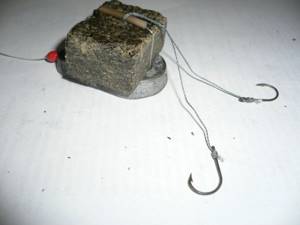
Installation is carried out in the following sequence:
- A briquette of makukha is attached to a flat lead sinker using a nylon cord.
- Several leashes with hooks are tied to the “ear” of the sinker.
- The hooks are pierced into the top of the head in such a way as to prevent their spontaneous release from the bait.
- This tackle is not sporting, and in most cases, hooking occurs while eating bait.
